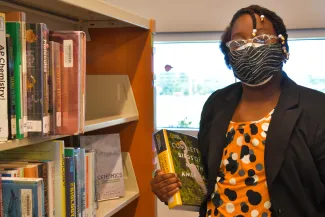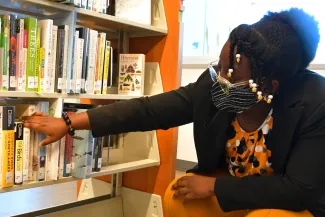
Matti Yarn, librarian at the Southwest Oklahoma City Library, brings their love of books and birds to work.
“The library is more than just a place where you can borrow books – it’s also a place where you can have experiences.”
As a librarian and former teacher, Matti Yarn delights in the chance to introduce people to new resources and ideas at the Southwest Oklahoma City Public Library. As a bird watcher and nature enthusiast, they’re especially excited when the library can be a gateway to the natural world.
Yarn has put their love of birds to work at the library, adding bird-themed experiences and building on the branch’s existing programing. In addition to the collection of nature guides housed at the Pioneer Library System branch, two bird feeding stations with anti-bird strike window treatments have been installed and library patrons have been invited to learn tips for identifying birds and how bird beaks have been engineered for their diets.
“I wanted to find a way to bring my love of birds to the library but wasn’t sure how interested our customers would be in my hobby,” Yarn said. “But we had our highest attendance for teens and adults at our first bird program. It’s been cool to have other people interested in and connect with what I’m interested in. And it’s really rewarding when our customers get a chance to see and interact with birds, and then ask questions. For me, that’s really powerful.”
The power of learning and its impact on communities has drawn Yarn to two careers, first as an Oklahoma City teacher, and now as a librarian. But the wonder of birds has called to Yarn since childhood in Virginia Beach, VA.
“I have to credit my 6th grade science teacher, Ms. K, for my interest in birds,” Yarn said. “I wasn’t that into it before a life sciences unit on birds. Whatever it was that she did for that unit – I got into it. We built bird houses and hung bird feeders, and my mom even got me a little bird book.
“Isn’t it amazing how our teachers can have such a profound impact on their students, even so many years later?”
Yarn soon became obsessed with the osprey that nested on a platform above their elementary school’s baseball field, and never looked back. Their birding experiences continued to grow while attending Cornell University, in New York, and has seeped into their library work in Oklahoma.
“I don’t have a life list, I’m more of a casual birder. But I still get really excited when I see new birds or identify birds by ear. I identified a Carolina wren just by its song the other day – it was a wild moment. And when I saw a golden-crowned kinglet – I had a fit.”
Yarn hopes to bring that same kind of wild joy to the library's customers.
As a librarian stationed in information services – better known as the reference desk – Yarn and their colleagues answer a variety of questions and point customers to a wide range of books and resources.
“No matter the question, our answer is typically ‘yes, we can help with that.’”
Yarn starts every exchange with a reference interview to get to the heart of the question, including questions about birds.
“Before we start looking at what books or resources may be available, we want to figure out what the customer specifically wants to know. The question may be about birds, but that could go in so many directions. It may be about how to build a bird house; or how to attract birds to their yard; or they might have a picture to show. We don’t want to make any assumptions.”
Once Yarn fully understands the question, they turn to the books and resources available in – and out – of the library.
“The library is known for its books – but we’re so much more. We have access to a lot of databases, scientific journals, and even outside resources.
“If the question is about attracting birds to their yard, we may check out the gardening section of the library. If the question is about how to prepare a bird they harvest, we may check out the cooking section. If the question is about bird migration or how the birds navigate south, we may check out one of the science journals we have access to. If the question is about bird identification, we may check out one of our field guides, or look into other resources like the Merlin, eBird, or iNaturalist apps.”

To help library customers find answers to their questions, Yarn leans on traditional library resources, but also searches through databases and scientific journals accessible through the library.
Yarn’s quest for answers and experiences – especially about birds and nature – shows how libraries can serve as a gateway to the natural world. But it can also lead to other fascinating places.
“There are so many opportunities at the library – and we’re just bursting with joy to tell you all about the things the library has to offer. I would love to see more people benefiting from this wonderful place we have.”
Find your local library and start exploring the natural world found inside with the Oklahoma Department of Libraries Public Library Locator.